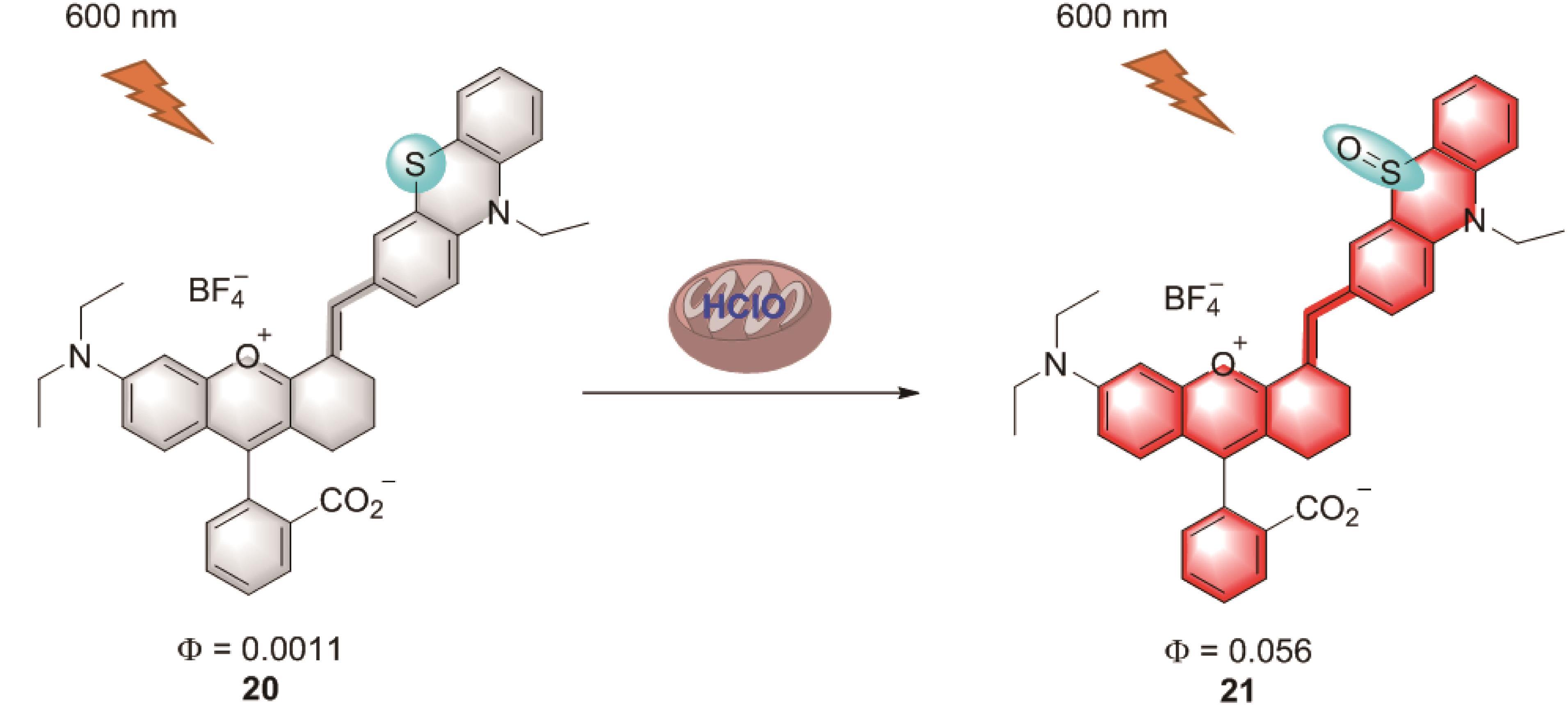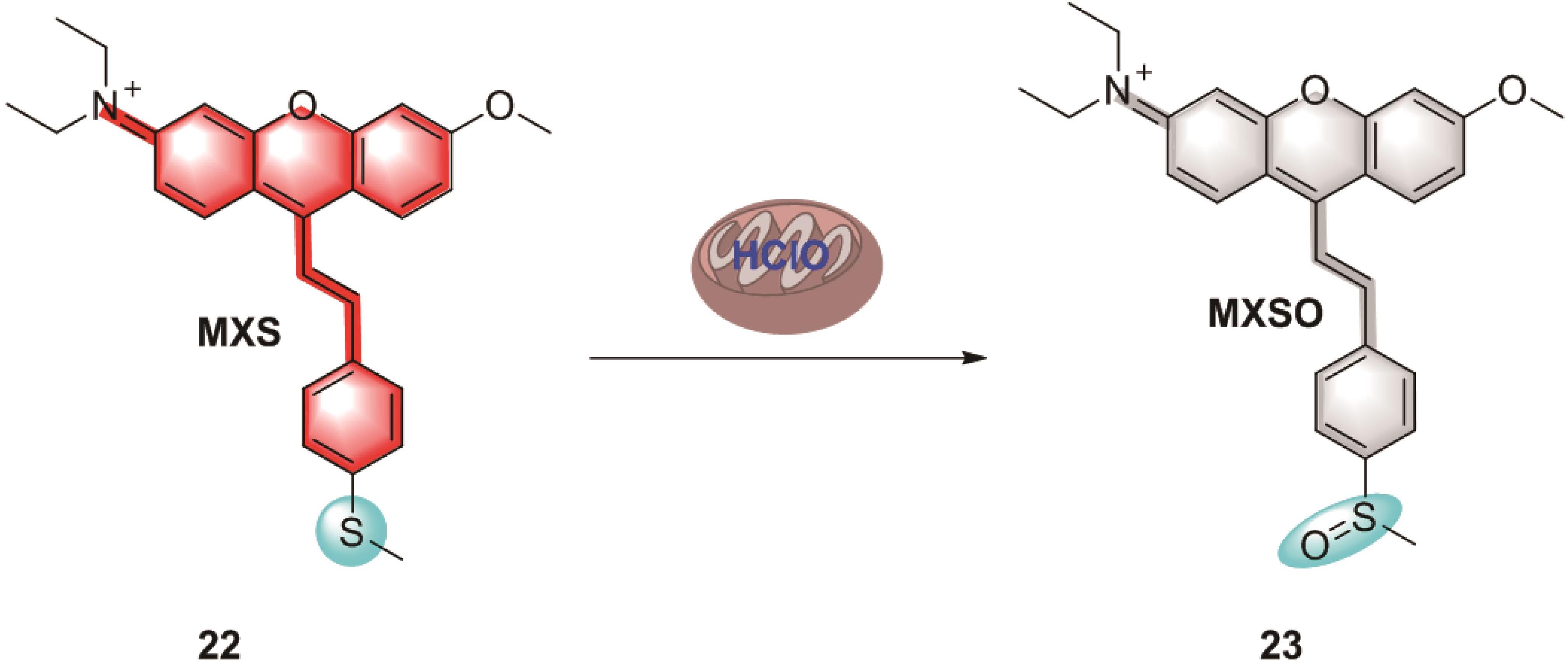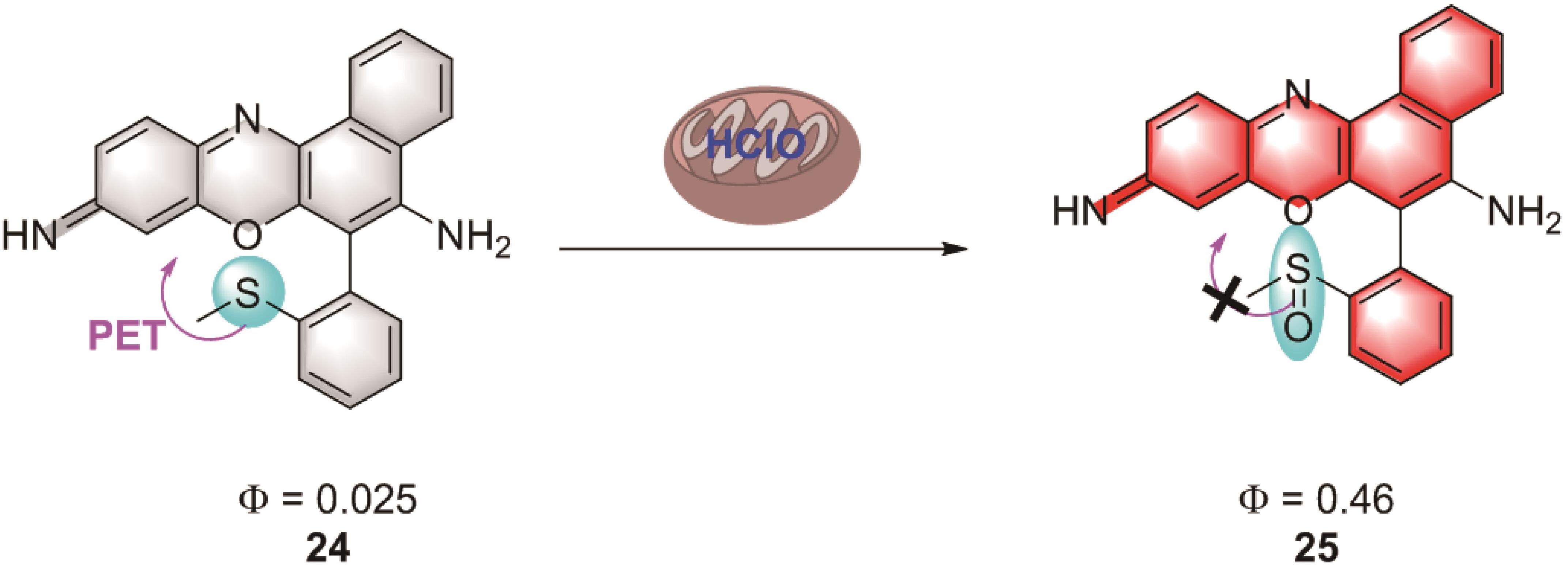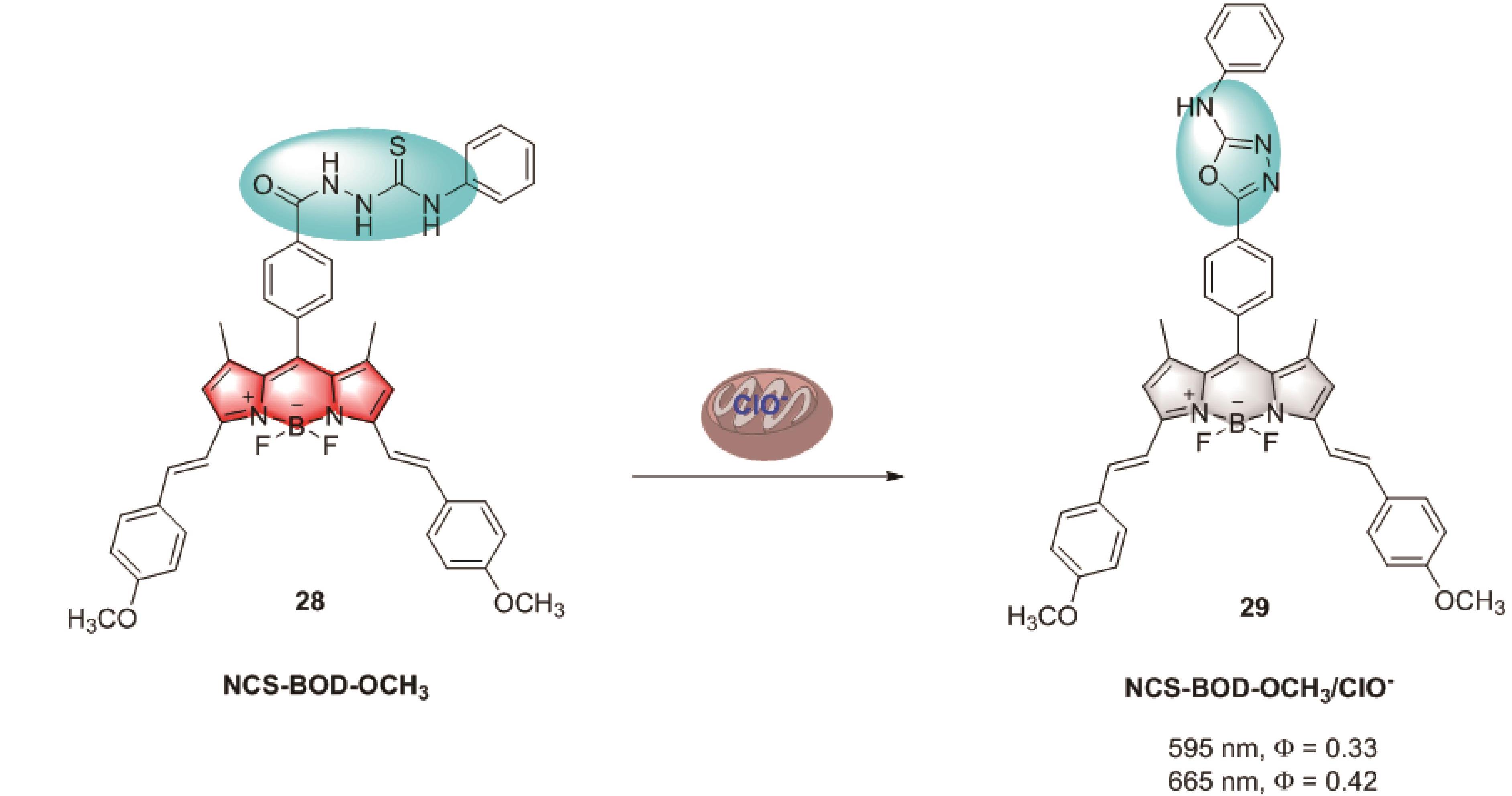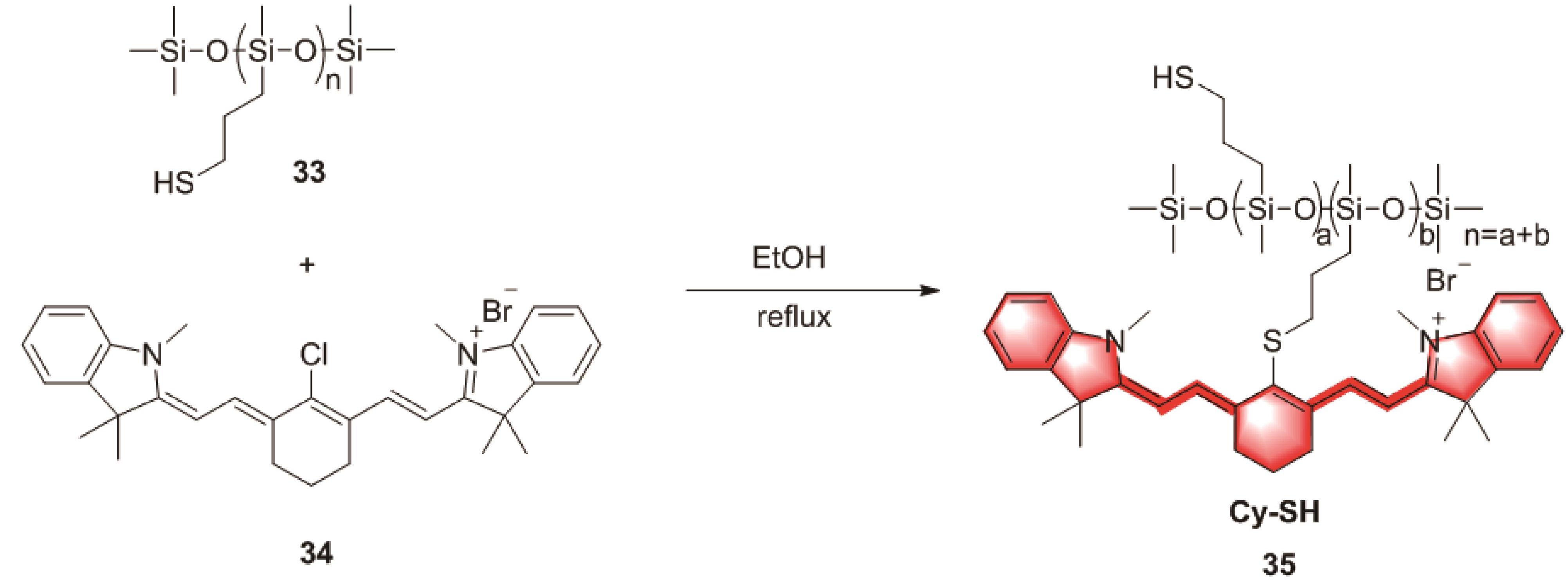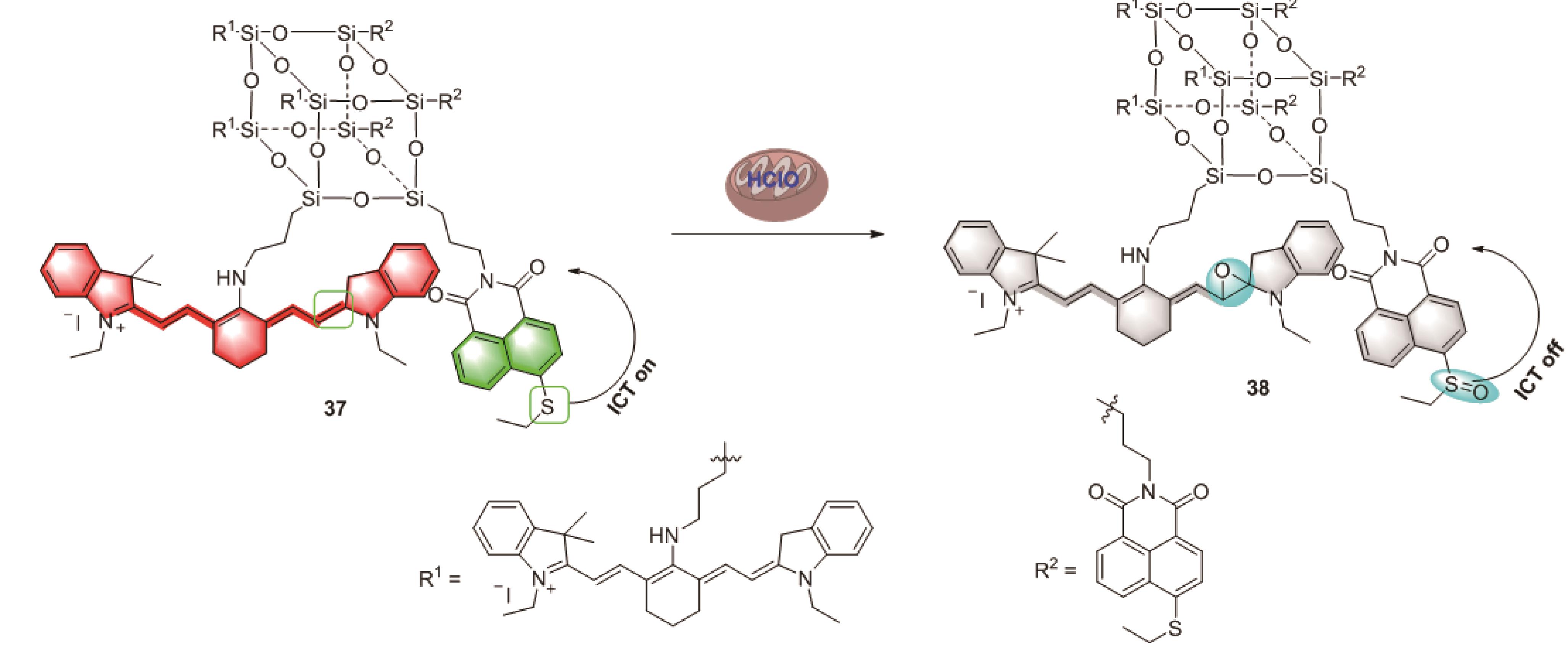
应用化学 ›› 2022, Vol. 39 ›› Issue (3): 407-424.DOI: 10.19894/j.issn.1000-0518.210583
线粒体靶向的近红外HClO/ClO-荧光探针的研究进展
黄蕊1, 叶长青2, 李亚军2, 邱盟峯2, 李达谅1( ), 鲍红丽2(
), 鲍红丽2( )
)
- 1.福建师范大学生命科学学院,福州 350117
2.中国科学院福建物质结构研究所,中国科学院煤制乙二醇及相关技术重点实验室,福州 350002
-
收稿日期:2021-12-29接受日期:2022-01-05出版日期:2022-03-01发布日期:2022-03-15 -
通讯作者:李达谅,鲍红丽 -
基金资助:福建师范大学创新研究计划Ⅱ项目(No.IRTL1703)和福建省自然科学基金(2021J01205)
Progress of Mitochondria⁃Targeted Near⁃Infrared HClO/ClO- Fluorescent Probes
Rui HUANG1, Chang-Qing YE2, Ya-Jun LI2, Mong-Feng CHIOU2, Da-Liang LI1( ), Hong-Li BAO2(
), Hong-Li BAO2( )
)
- 1.College of Life Sciences,Fujian Normal University,Fuzhou 350117,China
2.Key Laboratory of Coal to Ethylene Glycol and Its Related Technology,Fujian Institute of Research on the Structure of Matter,Chinese Academy of Sciences,Fuzhou 350002,China
-
Received:2021-12-29Accepted:2022-01-05Published:2022-03-01Online:2022-03-15 -
Contact:Da-Liang LI,Hong-Li BAO -
About author:hlbao@fjirsm.ac.cn; daliangli@fjnu.edu.cn
-
Supported by:the Innovative Research Teams Program II of Fujian Normal University in China(IRTL1703);the Natural Science Foundation of Fujian Province in China(2021J01205)
摘要:
HClO/ClO-作为细胞质中一种重要的活性氧(ROS),源自线粒体,参与各种生理和病理过程,因此快速有效检测HClO/ClO-具有重要的生物学及生理学意义。荧光分析法因其灵敏度高、响应时间快、选择性高、成本低和操作简便等优点而备受关注。更重要的是,使用荧光探针可以在体外和体内可视化检测。近年来,为了研究HClO/ClO-在细胞中的作用,已发展了一些靶向线粒体的荧光HClO/ClO-探针。其中,发射波长位于短波区域的探针存在背景荧光强、组织穿透性差等不足,因此,开发具有远红外至近红外发射的HClO/ClO-探针具有重要意义。本文围绕用于检测HClO/ClO-的线粒体靶向近红外荧光探针的最新动态展开讨论,将探针检测HClO/ClO-的反应类型分为不饱和双键的氧化、硫醚的氧化、氨基或酰肼的氧化和多位点的氧化等几个类别进行了归纳总结,希望为新一代高效灵敏、生物兼容性好的靶向性HClO/ClO-荧光探针的发展提供一定的帮助。
中图分类号:
引用本文
黄蕊, 叶长青, 李亚军, 邱盟峯, 李达谅, 鲍红丽. 线粒体靶向的近红外HClO/ClO-荧光探针的研究进展[J]. 应用化学, 2022, 39(3): 407-424.
Rui HUANG, Chang-Qing YE, Ya-Jun LI, Mong-Feng CHIOU, Da-Liang LI, Hong-Li BAO. Progress of Mitochondria⁃Targeted Near⁃Infrared HClO/ClO- Fluorescent Probes[J]. Chinese Journal of Applied Chemistry, 2022, 39(3): 407-424.
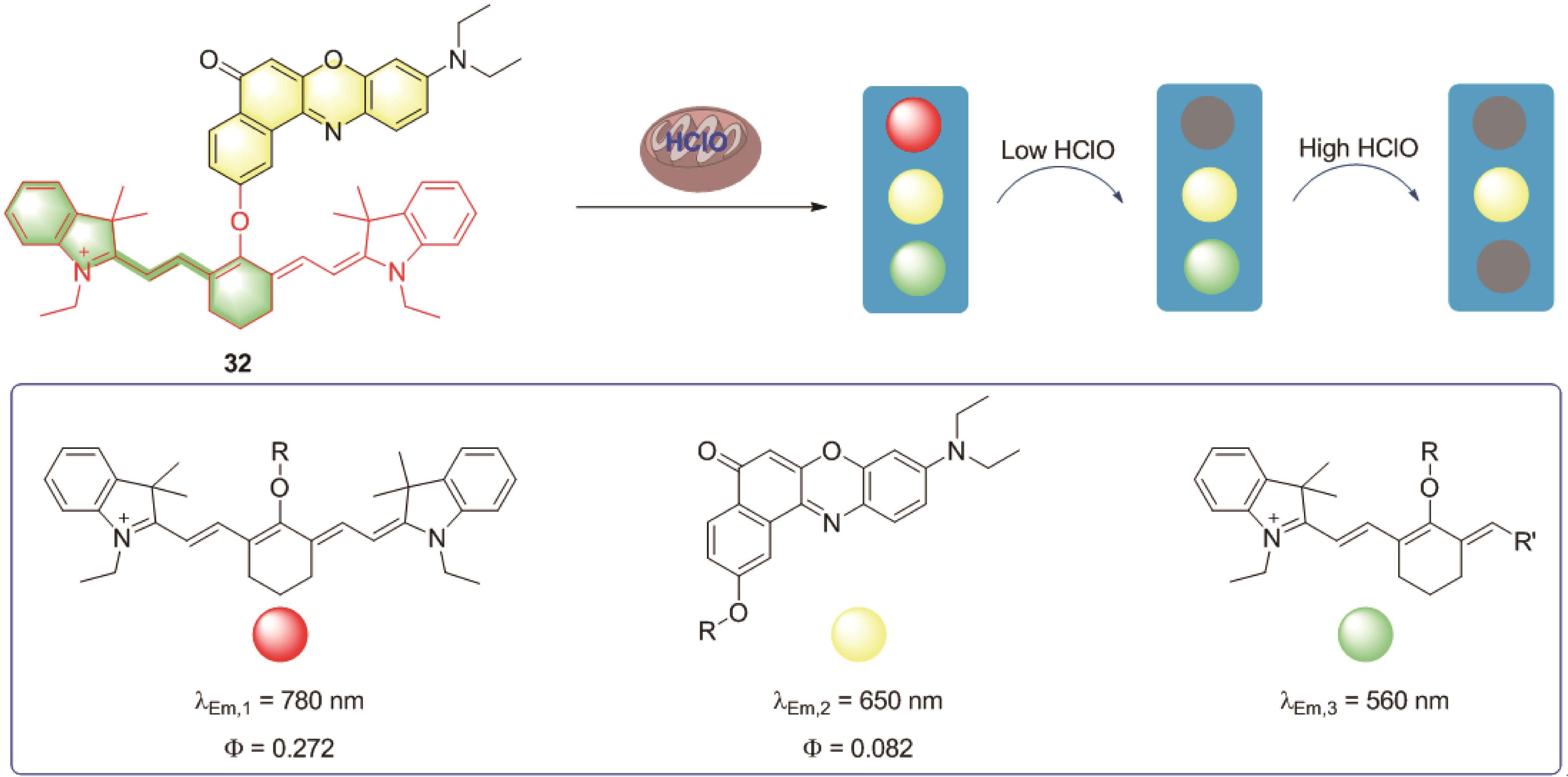
图15 荧光探针Cy7?Nil对不同浓度HClO/ClO-的荧光响应过程[86]
Fig.15 Fluorescence response process of Cy7?Nil fluorescent probe to different concentrations of HClO/ClO-[86]
序号 No. | 化合物名称 Compound's name | 化合物结构 Compound's structure | 荧光量子产率 Quantum yield(Φ) | 皮尔森或重叠系数 Pearson's/overlap coefficient | 检测限 Detection limit | 响应时间 Response time |
|---|---|---|---|---|---|---|
| 1 | CMBI |  | 0.012 | 0.94 | 33 nmol/L | 90 s |
表1 探针的性能
Table 1 Probe performance
序号 No. | 化合物名称 Compound's name | 化合物结构 Compound's structure | 荧光量子产率 Quantum yield(Φ) | 皮尔森或重叠系数 Pearson's/overlap coefficient | 检测限 Detection limit | 响应时间 Response time |
|---|---|---|---|---|---|---|
| 1 | CMBI |  | 0.012 | 0.94 | 33 nmol/L | 90 s |
| 1 | LIN M T, BEAL M F. Mitochondrial dysfunction and oxidative stress in neurodegenerative diseases[J]. Nature,2006, 443(7113): 787-795. |
| 2 | ADEGOKE O, FORBES P B C. Challenges and advances in quantum dot fluorescent probes to detect reactive oxygen and nitrogen species: a review[J]. Anal Chim Acta,2015, 862: 1-13. |
| 3 | HARRISON J E, SCHULTZ J. Studies on the chlorinating activity of myeloperoxidase[J]. J Biol Chem,1976, 251(5): 1371-1374. |
| 4 | YAP Y W, WHITEMAN M, BAY B H, et al. Hypochlorous acid induces apoptosis of cultured cortical neurons through activation of calpains and rupture of lysosomes[J]. J Neurochem,2006, 98(5): 1597-1609. |
| 5 | CHENG G, FAN J, SUN W, et al. A highly specific BODIPY-based probe localized in mitochondria for HClO imaging[J]. Analyst,2013, 138(20): 6091-6096. |
| 6 | HOU J T, WU M Y, LI K, et al. Mitochondria-targeted colorimetric and fluorescent probes for hypochlorite and their applications for in vivo imaging[J]. Chem Commun,2014, 50(63): 8640-8643. |
| 7 | ZHANG L J, ZHAO X, YANG D, et al. A new water-soluble and mitochondria-targeted fluorescence probe for ratiometric detection of hypochlorous acid in living cells[J]. Sens Actuators B: Chem, 2018, 276: 8-12. |
| 8 | WANG W, NING J Y, LIU J T, et al. A mitochondria-targeted ratiometric fluorescence sensor for the detection of hypochlorite in living cells[J]. Dyes Pigm,2019, 171: 107708. |
| 9 | WANG T R, ZHANG X F, HUANG X Q, et al. Rapid and selective visualization of mitochondrial hypochlorite by a red region water-soluble fluorescence probe[J]. Spectrochim Acta A: Mol Biomol Spectrosc,2021, 247: 119115. |
| 10 | MOBERG L, KARLBERG B. An improved N,N′-diethyl-p-phenylenediamine (DPD) method for the determination of free chlorine based on multiple wavelength detection[J]. Anal Chim Acta,2000, 407(1/2): 127-133. |
| 11 | ZHANG L J, WANG Z Y, CAO X J, et al. An effective ICT-based and ratiometric fluorescent probe for sensing sulfite[J]. Sens Actuators B,2016, 236: 741-748. |
| 12 | YUAN L, LIN W, ZHAO S, et al. A unique approach to development of near-infrared fluorescent sensors for in vivo imaging[J]. J Am Chem Soc,2012, 134(32): 13510-13523. |
| 13 | JUNG H S, HAN J H, KIM Z H, et al. Coumarin-Cu(II) ensemble-based cyanide sensing chemodosimeter[J]. Org Lett,2011, 13(19): 5056-5059. |
| 14 | GAO M, YU F, CHEN H, et al. Near-infrared fluorescent probe for imaging mitochondrial hydrogen polysulfides in living cells and in vivo[J]. Anal Chem,2015, 87(7): 3631-3638. |
| 15 | GUO Z, PARK S, YOON J, et al. Recent progress in the development of near-infrared fluorescent probes for bioimaging applications[J]. Chem Soc Rev,2014, 43(1): 16-29. |
| 16 | YUAN L, LIN W, ZHENG K, et al. Far-red to near infrared analyte-responsive fluorescent probes based on organic fluorophore platforms for fluorescence imaging[J]. Chem Soc Rev,2013, 42(2): 622-661. |
| 17 | KOIDE Y, URANO Y, HANAOKA K, et al. Development of an Si-rhodamine-based far-red to near-infrared fluorescence probe selective for hypochlorous acid and its applications for biological imaging[J]. J Am Chem Soc,2011, 133(15): 5680-5682. |
| 18 | SUN M, YU H, ZHU H, et al. Oxidative cleavage-based near-infrared fluorescent probe for hypochlorous acid detection and myeloperoxidase activity evaluation[J]. Anal Chem,2013, 86(1): 671-677. |
| 19 | LI H, GUAN L, ZHANG X, et al. A cyanine-based near-infrared fluorescent probe for highly sensitive and selective detection of hypochlorous acid and bioimaging[J]. Talanta, 2016, 161: 592-598. |
| 20 | LIN Q S, HUANG Y L, FAN X X, et al. A ratiometric fluorescent probe for hypochlorous acid determination: excitation and the dual-emission wavelengths at NIR region[J]. Talanta,2017, 170: 496-501. |
| 21 | WU L, WU I C, DUFORT C C, et al. Photostable ratiometric Pdot probe for in vitro and in vivo imaging of hypochlorous acid[J]. J Am Chem Soc,2017, 139(20): 6911-6918. |
| 22 | WANG X, MIN J, WANG W, et al. A novel porphyrin-based near-infrared fluorescent probe for hypochlorite detection and its application in vitro and in vivo[J]. Analyst,2018, 143(11): 2641-2647. |
| 23 | XI L L, GUO X F, WANG C L, et al. A near-infrared ratiometric fluorescent probe for rapid and selective detection of hypochlorous acid in aqueous solution and living cells[J]. Sens Actuators B: Chem,2018, 255: 666-671. |
| 24 | HUANG Y, HE N, WANG Y, et al. Detection of hypochlorous acid fluctuation via a selective near-infrared fluorescent probe in living cells and in vivo under hypoxic stress[J]. J Mater Chem B,2019, 7(15): 2557-2564. |
| 25 | GAO G, ZHAO P, ZHOU J, et al. A commercially available NIR fluorescence probe for the detection of hypochlorite and its application in cell imaging[J]. Microchem J,2020, 159: 105311. |
| 26 | LIN X, CHEN Y, BAO L, et al. A two-photon near-infrared fluorescent probe for imaging endogenous hypochlorite in cells, tissue and living mouse[J]. Dyes Pigm,2020, 174: 108113. |
| 27 | LIU L, WEI P, YUAN W, et al. Detecting basal myeloperoxidase activity in living systems with a near-infrared emissive “turn-on” probe[J]. Anal Chem,2020, 92(16): 10971-10978. |
| 28 | NIE J, SUN H, MIAO B, et al. A novel coumarin-based ratiometric near-infrared fluorescence probe for hypochlorous acid in living cells[J]. Dyes Pigm,2020, 181: 108590. |
| 29 | XU L, WU M, ZHAO L, et al. A novel highly sensitive and near-infrared fluorescent probe for detecting hypochlorite and its application in actual water sample and bioimaging[J]. Talanta,2020, 215: 120892. |
| 30 | YANG J, ZHENG W, SHEN Y, et al. A novel near-infrared fluorescent probe based on phenoxazine for the specific detection of HOCl[J]. J Lumin,2020, 226: 117460. |
| 31 | ZHANG M, ZUO M, WANG C, et al. Monitoring neuroinflammation with an HOCl-activatable and blood-brain barrier permeable upconversion nanoprobe[J]. Anal Chem,2020, 92(7): 5569-5576. |
| 32 | ZHENG W, YANG J, SHEN Y, et al. The near-infrared fluorescent probes based on phenoxazine for the rapid detection of hypochlorous acid[J]. Dyes Pigm,2020, 179: 108404. |
| 33 | FAN G, WANG N, ZHANG J, et al. BODIPY-based near-infrared fluorescent probe for diagnosis drug-induced liver injury via imaging of HClO in cells and in vivo[J]. Dyes Pigm,2021: 110073. |
| 34 | JIA X, WEI C, LI Z, et al. Selective imaging of HClO in the liver tissue in vivo using a near-infrared hepatocyte-specific fluorescent probe[J]. Chem Asian J,2021, 16(14): 1967-1972. |
| 35 | KAFUTI Y S, ZENG S, QIAN M, et al. A novel NIR fluorescent probe with fast response and large stokes shift for the detection and imaging of hypochlorous acid in living cells[J]. Dyes Pigm,2021: 110067. |
| 36 | ZHANG H, LIU J, LIU C, et al. Imaging lysosomal highly reactive oxygen species and lighting up cancer cells and tumors enabled by a Si-rhodamine-based near-infrared fluorescent probe[J]. Biomaterials,2017, 133: 60-69. |
| 37 | WANG J, CHENG D, ZHU L, et al. Engineering dithiobenzoic acid lactone-decorated Si-rhodamine as a highly selective near-infrared HOCl fluorescent probe for imaging drug-induced acute nephrotoxicity[J]. Chem Commun, 2019, 55(73): 10916-10919. |
| 38 | WU W L, MA H L, XI L L, et al. A novel lipid droplets-targeting ratiometric fluorescence probe for hypochlorous acid in living cells[J]. Talanta,2019, 194: 308-313. |
| 39 | CAO C, ZHOU X, XUE M, et al. Dual near-infrared-emissive luminescent nanoprobes for ratiometric luminescent monitoring of ClO– in living organisms[J]. ACS Appl Mater Interfaces,2019, 11(17): 15298-15305. |
| 40 | WANG S, LIU L, FAN Y, et al. In vivo high-resolution ratiometric fluorescence imaging of inflammation using NIR-II nanoprobes with 1550 nm emission[J]. Nano Lett,2019, 19(4): 2418-2427. |
| 41 | GE X, LOU Y, SU L, et al. Single wavelength laser excitation ratiometric NIR-II fluorescent probe for molecule imaging in vivo[J]. Anal Chem,2020, 92(8): 6111-6120. |
| 42 | WU P, ZHU Y, CHEN L, et al. A fast-responsive off⁃on near-infrared-II fluorescent probe for in vivo detection of hypochlorous acid in rheumatoid arthritis[J]. Anal Chem,2021, 93(38): 13014-13021. |
| 43 | ZHANG M, WANG Z, WANG C, et al. Visualizing oxidative stress level for timely assessment of ischemic stroke via a ratiometric near-infrared-II luminescent nanoprobe[J]. ACS Nano,2021, 15(7): 11940-11952. |
| 44 | WANG L, LIU J, ZHANG H, et al. Discrimination between cancerous and normal cells/tissues enabled by a near-infrared fluorescent HClO probe[J]. Sens Actuators B: Chem,2021, 334: 129602. |
| 45 | ZHANG Y Y, CHEN X Z, LIU X Y, et al. A highly selective and ultrafast near-infrared fluorescent turn-on and colorimetric probe for hypochlorite in living cells[J]. Anal Chim Acta,2019, 1078: 135-141. |
| 46 | DENG Y, FENG S, XIA Q, et al. A novel reaction-based fluorescence probe for rapid imaging of HClO in live cells, animals, and injured liver tissues[J]. Talanta,2020, 215: 120901. |
| 47 | HE M, YE M, WANG Z, et al. A ratiometric near-infrared fluorescent probe with a large emission peak shift for sensing and imaging hypochlorous acid[J]. Sens Actuators B: Chem,2021, 343: 130063. |
| 48 | ZHANG H, YIN X, HONG J, et al. A NIR fluorescence probe having significant fluorescence turn-on signal at 700 nm and large Stokes shift for rapid detection of HOCl in vivo[J]. Talanta,2021, 223: 121768. |
| 49 | TONG H, ZHANG Y, MA S, et al. A pinacol boronate caged NIAD-4 derivative as a near-infrared fluorescent probe for fast and selective detection of hypochlorous acid[J]. CHIN Chem Lett,2018, 29(1): 139-142. |
| 50 | ZHOU Z, YUAN X, LONG D, et al. A pyridine-Si-rhodamine-based near-infrared fluorescent probe for visualizing reactive oxygen species in living cells[J]. Spectrochim Acta A: Mol Biomol Spectrosc,2021, 246: 118927. |
| 51 | XU J, YUAN H, QIN C, et al. A mitochondria-targeted near-infrared probe for colorimetric and ratiometric fluorescence detection of hypochlorite in living cells[J]. RSC Adv,2016, 6(109): 107525-107532. |
| 52 | XU J, PAN J, JIANG X, et al. A mitochondria-targeted ratiometric fluorescent probe for rapid, sensitive and specific detection of biological SO2 derivatives in living cells[J]. Biosens Bioelectron,2016, 77: 725-732. |
| 53 | LIU Y, LI K, XIE K X, et al. A water-soluble and fast-response mitochondria-targeted fluorescent probe for colorimetric and ratiometric sensing of endogenously generated SO2 derivatives in living cells[J]. Chem Commun, 2016, 52(16): 3430-3433. |
| 54 | LAN J S, LIU L, ZENG R F, et al. Rational modulation of coumarin-hemicyanine platform based on OH substitution for higher selective detection of hypochlorite[J]. Chem Comm,2020, 56(8): 1219-1222. |
| 55 | LIU J, SUN Y Q, ZHANG H, et al. A carboxylic acid-functionalized coumarin-hemicyanine fluorescent dye and its application to construct a fluorescent probe for selective detection of cysteine over homocysteine and glutathione[J]. RSC Adv,2014, 4(110): 64542-64550. |
| 56 | ZHANG L J, WANG Z Y, LIU J T, et al. A rational design of ratiometric fluorescent probes based on new ICT/FRET platform and imaging of endogenous sulfite in living cells[J]. Sens Actuators B: Chem,2017, 253: 19-26. |
| 57 | HUANG Y, ZHANG Y, HUO F, et al. A near-infrared ratiometric fluorescent probe with large stokes based on isophorone for rapid detection of ClO- and its bioimaging in cell and mice[J]. Sens Actuators B: Chem,2019, 287: 453-458. |
| 58 | XIONG K, HUO F, ZHANG Y, et al. A NIR ratiometric fluorescent probe for the ‘naked-eye’ detection of endogenous hypochlorous acid in practical samples[J]. Anal Methods,2019, 11(13): 1751-1756. |
| 59 | HUANG Y, ZHANG Y, HUO F, et al. Mitochondrial-targeted near-infrared “dual mode” fluorescent dyes with large Stokes shift for detection of hypochlorous acid and its bioimaging in cell and mice[J]. Dyes Pigm,2020, 179: 108387. |
| 60 | REN H, HUO F,YIN C. An ESIPT-based colorimetric and fluorescent probe with large Stokes shift for the sensitive detection of hypochlorous acid and its bioimaging in cells[J]. New J Chem,2021, 45(10): 4724-4728. |
| 61 | PANG Q, LI T, YIN C, et al. Comparing the abundance of HClO in cancer/normal cells and visualizing in vivo using a mitochondria-targeted ultra-fast fluorescent probe[J]. Analyst,2021, 146(10): 3361-3367. |
| 62 | OUSHIKI D, KOJIMA H, TERAI T, et al. Development and application of a near-infrared fluorescence probe for oxidative stress based on differential reactivity of linked cyanine dyes[J]. J Am Chem Soc,2010, 132(8): 2795-2801. |
| 63 | CHENG G, FAN J, SUN W, et al. A near-infrared fluorescent probe for selective detection of HClO based on Se-sensitized aggregation of heptamethine cyanine dye[J]. Chem Commun,2014, 50(8): 1018-1020. |
| 64 | JIANG C, LI Y, YAN L, et al. A ratiometric fluorescence mitochondrial-targeted probe for imaging HOCl in vitro and in vivo[J]. Dyes Pigm,2022, 198: 109975. |
| 65 | ZHAO X J, JIANG Y R, CHEN Y X, et al. A new “off-on” NIR fluorescence probe for determination and bio-imaging of mitochondrial hypochlorite in living cells and zebrafish[J]. Spectrochim Acta A: Mol Biomol Spectrosc,2019, 219: 509-516. |
| 66 | YUAN L, LIN W,CHEN H. Analogs of Changsha near-infrared dyes with large Stokes shifts for bioimaging[J]. Biomaterials,2013, 34(37): 9566-9571. |
| 67 |
CHENG X, JIA H, LONG T, et al. A “turn-on” fluorescent probe for hypochlorous acid: convenient synthesis, good sensing performance, and a new design strategy by the removal of C N isomerization[J]. Chem Comm,2011, 47(43): 11978. N isomerization[J]. Chem Comm,2011, 47(43): 11978.
|
| 68 | WANG Y, XIA J, HAN J, et al. A fast-responsive fluorescent probe based on BODIPY dye for sensitive detection of hypochlorite and its application in real water samples[J]. Talanta,2016, 161: 847-853. |
| 69 | TIAN F, JIA Y, ZHANG Y, et al. A HClO-specific near-infrared fluorescent probe for determination of Myeloperoxidase activity and imaging mitochondrial HClO in living cells[J]. Biosens Bioelectron,2016, 86: 68-74. |
| 70 | JIAO X, HUANG K, HE S, et al. A mitochondria-targeted near-infrared fluorescent probe with a large Stokes shift for real-time detection of hypochlorous acid[J]. Org Biomol Chem,2019, 17(1): 108-114. |
| 71 | GONG J, LIU C, CAI S, et al. Novel near-infrared fluorescent probe with a large Stokes shift for sensing hypochlorous acid in mitochondria[J]. Org Biomol Chem,2020, 18(38): 7656-7662. |
| 72 | CARTER K P, YOUNG A M, PALMER A E. Fluorescent sensors for measuring metal ions in living systems[J]. Chem Rev,2014, 114(8): 4564-4601. |
| 73 | YANG Y, ZHAO Q, FENG W, et al. Luminescent chemodosimeters for bioimaging[J]. Chem Rev,2012, 113(1): 192-270. |
| 74 | BEIJA M, AFONSO C A M, MARTINHO J M G. Synthesis and applications of Rhodamine derivatives as fluorescent probes[J]. Chem Soc Rev,2009, 38(8): 2410. |
| 75 | QUANG D T, KIM J S. Fluoro- and chromogenic chemodosimeters for heavy metal ion detection in solution and biospecimens[J]. Chem Rev,2010, 110(10): 6280-6301. |
| 76 | ZHENG A, LIU H, PENG C, et al. A mitochondria-targeting near-infrared fluorescent probe for imaging hypochlorous acid in cells[J]. Talanta,2021, 226: 122152. |
| 77 | MA H, ZHANG J, ZHANG Z, et al. A fast response and red emission probe for mammalian thioredoxin reductase[J]. Chem Commun,2016, 52(81): 12060-12063. |
| 78 | GUO T, CUI L, SHEN J, et al. A highly sensitive long-wavelength fluorescence probe for nitroreductase and hypoxia: selective detection and quantification[J]. Chem Comm,2013, 49(92): 10820. |
| 79 | HO N H, WEISSLEDER R, TUNG C H. A self-immolative reporter for β-galactosidase sensing[J]. ChemBioChem,2007, 8(5): 560-566. |
| 80 | ZHU B, WU L, ZHANG M, et al. A highly specific and ultrasensitive near-infrared fluorescent probe for imaging basal hypochlorite in the mitochondria of living cells[J]. Biosens Bioelectron,2018, 107: 218-223. |
| 81 | SHEN B X, QIAN Y, QI Z Q, et al. Near-infrared BODIPY-based two-photon ClO- probe based on thiosemicarbazide desulfurization reaction: naked-eye detection and mitochondrial imaging[J]. J Mater Chem B,2017, 5(29): 5854-5861. |
| 82 | SHEN B X, QIAN Y. A novel triphenylamine-BODIPY dendron: click synthesis, near-infrared emission and a multi-channel chemodosimeter for Hg2+ and Fe3+[J]. J Mater Chem B,2016, 4(47): 7549-7559. |
| 83 | SHEN B X, QIAN Y. Click synthesis, Hg2+ sensor and intramolecular fluorescence resonance energy transfer in novel BODIPY dendrons[J]. Sens Actuators B: Chem,2017, 239: 226-234. |
| 84 | MAO G J, GAO G Q, LIANG Z Z, et al. A mitochondria-targetable two-photon fluorescent probe with a far-red to near-infrared emission for sensing hypochlorite in biosystems[J]. Anal Chim Acta,2019, 1081: 184-192. |
| 85 | MAO G J, WANG Y Y, DONG W P, et al. A lysosome-targetable two-photon excited near-infrared fluorescent probe for visualizing hypochlorous acid-involved arthritis and its treatment[J]. Spectrochim Acta A,2021, 249: 119326. |
| 86 | LIN X, QIN W, CHEN Y, et al. Construction of a multi-signal near-infrared fluorescent probe for sensing of hypochlorite concentration fluctuation in living animals[J]. Sens Actuators B: Chem,2020, 324: 128732. |
| 87 | MAO Z, FENG W, LI Z, et al. NIR in, far-red out: developing a two-photon fluorescent probe for tracking nitric oxide in deep tissue[J]. Chem Sci,2016, 7(8): 5230-5235. |
| 88 | REN H Y, LIU B F, KONG F, et al. Improved Nile red staining of Scenedesmus sp. by combining ultrasonic treatment and three-dimensional excitation emission matrix fluorescence spectroscopy[J]. Algal Res,2015, 7: 11-15. |
| 89 | KREDER R, PYRSHEV K A, DARWICH Z, et al. Solvatochromic Nile red probes with FRET quencher reveal lipid order heterogeneity in living and apoptotic cells[J]. ACS Chem Biol,2015, 10(6): 1435-1442. |
| 90 | HAN J, JOSE J, MEI E, et al. Chemiluminescent energy-transfer cassettes based on fluorescein and Nile red[J]. Angew Chem Int Ed,2007, 46(10): 1684-1687. |
| 91 | NJIOJOB C N, OWENS E A, NARAYANA L, et al. Tailored near-infrared contrast agents for image guided surgery[J]. J Med Chem,2015, 58(6): 2845-2854. |
| 92 | WANG X, LV J, YAO X, et al. Screening and investigation of a cyanine fluorescent probe for simultaneous sensing of glutathione and cysteine under single excitation[J]. Chem Commun,2014, 50(97): 15439-15442. |
| 93 | CHEN G, SONG F, WANG J, et al. FRET spectral unmixing: a ratiometric fluorescent nanoprobe for hypochlorite[J]. Chem Commun,2012, 48(24): 2949. |
| 94 | KIYOSE K, AIZAWA S, SASAKI E, et al. Molecular design strategies for near-infrared ratiometric fluorescent probes based on the unique spectral properties of aminocyanines[J]. Chem Eur J,2009, 15(36): 9191-9200. |
| 95 | LIU L, JIANG L, YUAN W, et al. Dual-modality detection of early-stage drug-induced acute kidney injury by an activatable probe[J]. ACS Sens, 2020, 5(8): 2457-2466. |
| 96 | ZUO Y, WANG X, GOU Z, et al. Reversible polysiloxane-based near-infrared fluorescent probe for monitoring the redox cycles between HClO/SO2 in mitochondria and in vivo[J]. Sens Actuators B: Chem,2021, 344: 130217. |
| 97 | AN Z, SHAN T, HE H, et al. Contradiction or unity? thermally stable fluorescent probe for in situ fast identification of self-sort or co-assembly of multicomponent gelators with sensitive properties[J]. ACS Appl Mater Interfaces,2021, 13(7): 8774-8781. |
| 98 | LI Y, ZHANG L, LI C. Highly transparent and scratch resistant polysiloxane coatings containing silica nanoparticles[J]. J Colloid Interface Sci,2020, 559: 273-281. |
| 99 | BAHRAMI Z, AKBARI A, EFTEKHARI-SIS B. Double network hydrogel of sodium alginate/polyacrylamide cross-linked with POSS: swelling, dye removal and mechanical properties[J]. Int J Biol Macromol,2019, 129: 187-197. |
| 100 | YU J, LIU Y. Cyclic polysiloxanes with linked cyclotetrasiloxane subunits[J]. Angew Chem Int Ed,2017, 56(30): 8706-8710. |
| 101 | REN Z, YAN S. Polysiloxanes for optoelectronic applications[J]. Prog Mater Sci,2016, 83: 383-416. |
| 102 | YE Y, ZHANG D, LIU T, et al. Improvement of anticorrosion ability of epoxy matrix in simulate marine environment by filled with superhydrophobic POSS-GO nanosheets[J]. J Hazard Mater,2019, 364: 244-255. |
| 103 | WANG S, GU K, YAN C, et al. POSS: a morphology-tuning strategy to improve the sensitivity and responsiveness of dissolved oxygen sensor[J]. Ind Eng Chem Res,2019, 58(19): 7761-7768. |
| 104 | KAVUNCUOGLU H, YALCIN H, DOGAN M. Production of polyhedral oligomeric silsesquioxane(POSS) containing low density polyethylene (LDPE) based nanocomposite films for minced beef packaging for extension of shelf life[J]. Lwt,2019, 108: 385-391. |
| 105 | LIU J, YU H, LIANG Q, et al. Preparation of polyhedral oligomeric silsesquioxane based cross-linked inorganic-organic nanohybrid as adsorbent for selective removal of acidic dyes from aqueous solution[J]. J Colloid Interface Sci,2017, 497: 402-412. |
| 106 | KAKUTA T, NARIKIYO H, JEON J H, et al. Development of highly-sensitive detection system in 19F NMR for bioactive compounds based on the assembly of paramagnetic complexes with fluorinated cubic silsesquioxanes[J]. Bioorg Med Chem,2017, 25(4): 1389-1393. |
| 107 | ZHOU Z, HAN Z, LU Z R. A targeted nanoglobular contrast agent from host-guest self-assembly for MR cancer molecular imaging[J]. Biomaterials,2016, 85: 168-179. |
| 108 | ZHANG Y, SHEN H Y, HAI X, et al. Polyhedral oligomeric silsesquioxane polymer-caged silver nanoparticle as a smart colorimetric probe for the detection of hydrogen sulfide[J]. Anal Chem,2016, 89(2): 1346-1352. |
| 109 | QIAN M, MURRAY V J, WEI W, et al. Resistance of POSS polyimide blends to hyperthermal atomic oxygen attack[J]. ACS Appl Mater Interfaces,2016, 8(49): 33982-33992. |
| 110 | DING G, ZUO Y, GAI F, et al. A POSS-assisted fluorescent probe for the rapid detection of HClO in mitochondria with a large emission wavelength in dual channels[J]. J Mater Chem B,2021, 9(34): 6836-6843. |
| [1] | 于红丽, 周思仪, 洪琛, 罗稳. 基于黄酮骨架的“关-开”型荧光探针用于检测活细胞内丁酰胆碱酯酶[J]. 应用化学, 2023, 40(4): 500-508. |
| [2] | 耿佳美, 马素芳, 刘文, 刁海鹏, 武志芳, 李思进. 肝靶向荧光探针用于HepG2细胞中ONOO-的特异性检测[J]. 应用化学, 2023, 40(3): 441-448. |
| [3] | 薛松松, 解正峰, 何佳伟, 张天怡, 夏保平, 李雨芹. 高选择性快速识别汞(Ⅱ)离子的磺酰腙型探针的合成及在吸附中的应用[J]. 应用化学, 2022, 39(5): 760-768. |
| [4] | 张松涛, 王樱蕙, 张洪杰. Nd3+离子敏化的荧光纳米探针用于近红外二区血管成像[J]. 应用化学, 2022, 39(4): 685-693. |
| [5] | 张成路, 王一鸣, 任芷漩, 李露, 李雨晴, 宋府璐. 以苯并咪唑萘酰亚胺为荧光团高选择快速检测H2S的荧光探针[J]. 应用化学, 2022, 39(3): 489-497. |
| [6] | 于思为, 王良鹏, 金日哲, 康传清. 氧杂蒽类荧光探针对ClO-的识别和细胞成像应用[J]. 应用化学, 2022, 39(12): 1903-1911. |
| [7] | 张成路, 暴金迪, 于丰铭, 董文静, 张洋, 宫荣庆, 张彦朋, 张璐. 以喹唑啉酮为核心高选择高灵敏识别次氯酸根离子的荧光探针的合成及应用[J]. 应用化学, 2021, 38(8): 986-994. |
| [8] | 黄译文, 王丽艳, 赵冰, 宋波. 一种水溶性甲氧基萘乙烯半菁合成及对铬(Ⅲ)离子的荧光检测[J]. 应用化学, 2021, 38(11): 1503-1511. |
| [9] | 徐丽萍, 刘清士, 董芷辰, 郭兴家, 董微. 基于氮掺杂碳点的荧光增强简便、快速而准确地检测环丙沙星[J]. 应用化学, 2020, 37(7): 830-838. |
| [10] | 赵凯超, 赵旭, 严秀平. pH可逆激活型不对称菁光敏剂的光动力杀菌活性[J]. 应用化学, 2020, 37(6): 620-626. |
| [11] | 李伟佳, 马志方, 辛志荣, 石强. 二维层状钴铁双氢氧化物用于癌症协同光治疗[J]. 应用化学, 2020, 37(6): 627-634. |
| [12] | 赵凯超, 赵旭, 严秀平. pH可逆激活型不对称菁光敏剂的光动力杀菌活性[J]. 应用化学, 2020, 37(6): 0-. |
| [13] | 蔡丰泽, 徐永玲, 周乐, 许丙嵩, 陈浩, 孙建强, 李迪, 王慧. 一种红光发射的粘度荧光探针[J]. 应用化学, 2020, 37(4): 440-446. |
| [14] | 董子越, 周晓霞, 赵晓慧, 叶达莹, 安悦. 一种可用于检测2,4,6-三硝基苯酚的杂环芳族卤化物小分子荧光探针[J]. 应用化学, 2020, 37(3): 332-339. |
| [15] | 董智云, 张晓宇, 曾政权, 席福贵. 基于蒽-苯并咪唑鎓的荧光传感器对H2PO4-的高选择性识别[J]. 应用化学, 2020, 37(1): 80-87. |
| 阅读次数 | ||||||
|
全文 |
|
|||||
|
摘要 |
|
|||||








